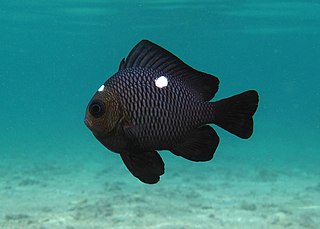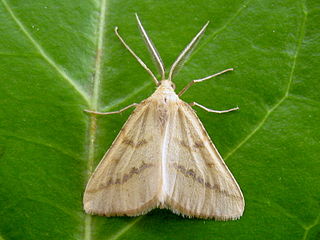
Pietro Rossi was an Italian scientist and entomologist.

Slushko Palace in Vilnius, Lithuania is a Baroque palace situated on the left bank of Neris River in the Old Town elderate, former Antakalnis suburb of the city.

The threespot dascyllus, also known as the domino damsel or simply domino, is a species of damselfish from the family Pomacentridae. It is native to the Indo-Pacific from the Red Sea and East Africa, to the Pitcairn Islands, southern Japan, and Australia. Its grey to black body has two lateral white spots and one between the eyes like domino hence the name; the threespot dascyllus grows up to 13 cm in length. Coloration is somewhat variable; the spot on the forehead may be absent and the lateral spots very much reduced. It feeds on algae, copepods and other planktonic crustaceans.

Erythraeidae is a family of mites belonging to the Trombidiformes. Larval forms of these mites are parasitic on various other arthropods, for example harvestmen, but the adults are free-living predators. These oval mites are rather large, usually reddish coloured and densely hairy. The legs, especially the first and fourth pairs, are long and adapted for running. They have either one or two pairs of eyes and can be distinguished from related families microscopically by the presence of a single claw on the tibia of the palp.

Leptus is a genus of large mites belonging to the family Erythraeidae; they resemble members of the related genus Balaustium, but can be distinguished by the eyes, which in Leptus species are set much further forward on the body than in Balaustium species.

The flat-faced seahorse, longnose seahorse, low-crowned seahorse or three-spot seahorse is a species of fish in the family Syngnathidae. It is found in Australia, Cocos (Keeling) Islands, French Polynesia, Hong Kong, India, Indonesia, Japan, the Philippines, Singapore, Taiwan, Thailand, and Vietnam. Its natural habitat is shallow seas. It is threatened by habitat loss.

Hipponix, common name hoof snails or hoof shells, is a genus of small sea snails with limpet-like shells, marine gastropod molluscs in the family Hipponicidae, the hoof snails. Many of the species in this genus have white shells.

Retodus is an extinct genus of prehistoric lungfish found in Cretaceous-aged freshwater strata of Egypt, Algeria and Niger. The type species, R. tuberculatus, was named in 2006. It was originally named as a species of Ceratodus and Neoceratodus in 1963.

Aspitates ochrearia, the yellow belle, is a moth in the family Geometridae. The species was first described by Pietro Rossi in 1794. It is found in western and southern Europe, as well as North America.

Apolemichthys trimaculatus, the threespot angelfish or flagfin angelfish, is a demersal marine ray-finned fish, a marine angelfish belonging to the family Pomacanthidae. It has a wide Indo-Pacific distribution.

Nysson is a Holarctic genus of kleptoparasitic wasps in the family Crabronidae. Over 100 species are known.

Tachytes etruscus is a predatory, solitary wasp belonging to the family Crabronidae. The species was first described by Pietro Rossi in 1790.
Antonio Simeone Sografi, also known as Antonio Simon, or just Antonio, was an Italian librettist and playwright.

Tabanus trimaculatus is a species of horse fly in the family Tabanidae.
Tabanus petiolatus is a species of horse fly in the family Tabanidae. Unlike many Tabanus species, the color pattern of male eyes is found in the larger, upper lenses - appearing as a dark, brown streak across the light colored lens. Females of this species have uniformly colored dark brown eyes. Often confused with Tabanus melanocerus or Tabanus trimaculatus.

Byrrhus is a genus of pill beetles in the family Byrrhidae. There are at least 30 described species in Byrrhus.

Tabanus melanocerus is a species of horse fly in the family Tabanidae. Often confused with Tabanus petiolatus or Tabanus trimaculatus.

Lestiphorus is a genus of sand wasps in the family Crabronidae. There are about 18 described species in Lestiphorus.

Rhyparochromus is a genus of dirt-colored seed bugs in the family Rhyparochromidae. There are more than 40 described species in Rhyparochromus.

Aphelocheirus is a genus of true bugs belonging to the family Aphelocheiridae.


















